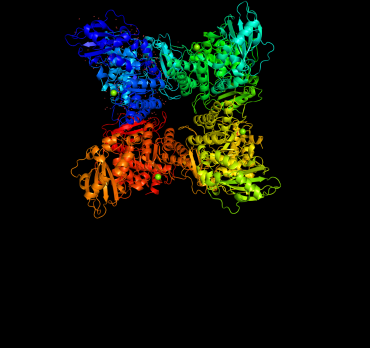
The world’s most prolific carbon-fixing enzyme is slowly getting better
New research led by the University of Oxford has found that rubisco – the enzyme that fuels all life on Earth – is not stuck in an evolutionary rut after all. The largest analysis of rubisco ever has found that it is improving all the time – just very, very slowly. These insights could potentially open up new routes to strengthen food security. The results have been published today in Proceedings of the National Academy of Sciences [PNAS].
We have shown that rubisco is not frozen in time but is instead continually evolving to get better. We now need to understand the factors that are holding rubisco back to enable us to realise its true potential.
Senior author Professor Steven Kelly (Department of Biology, University of Oxford)
The most abundant enzyme on Earth, rubisco, has been providing the energy which fuels life on our planet for the last three billion years. While rubisco fixes billions of tons of CO2 each year, the enzyme is notoriously inefficient. This has created a biological paradox that has puzzled researchers for decades. Why is the enzyme that has been fuelling life for over 3 billion years not much better at doing its job? Many plant scientists have debated whether the enzyme is stuck in an 'evolutionary rut', making it impossible for it to get any better.
But new research from the University of Oxford has revealed that rubisco is continually improving, but that this improvement is occurring at a glacial pace.
Lead author Jacques Bouvier, a DPhil student in Oxford's Department of Biology, said: ‘Our research demonstrates for the first time that evolution is consistently improving rubisco and that further improvement of the enzyme is possible. Importantly, this insight provides renewed optimism for efforts to engineer the enzyme to help feed the world.’
The researchers analysed rubisco gene sequences from across a wide range of photosynthetic organisms and quantified the rate of rubisco evolution for the first time. They found that its sequence has altered in minute increments of just one DNA base change every 900,000 years – a stark contrast from the COVID-19 genome, for example, which is evolving one base change every two weeks. This puts rubisco in the 1% of slowest evolving genes on Earth.
 Rubisco, believed to be the most abundant enzyme on the planet, catalyses the fixation of carbon dioxide during photosynthesis. This shows a model of rubisco from spinach. Image credit: Taylor, T.C., Andersson, I. Wikimedia Commons.
Rubisco, believed to be the most abundant enzyme on the planet, catalyses the fixation of carbon dioxide during photosynthesis. This shows a model of rubisco from spinach. Image credit: Taylor, T.C., Andersson, I. Wikimedia Commons.For decades scientists have aspired to engineer an improved rubisco to boost growth and yields of crop plants. But despite much effort, success has been limited, and many have wondered whether rubisco is already optimised, making these attempts futile. However, the insights from this study offer renewed hope. In particular, unravelling the mystery of what is holding back rubisco’s rate of evolution may uncover new ways of enhancing crop yields.
Jacques Bouvier added: 'Because rubisco assimilates the sugars which fuel life on Earth, improving this enzyme is one of the most promising avenues to help combat food insecurity. There has been heated debate as to whether there is scope to improve the enzyme; our new research provides a clear answer to this question. If evolution can improve rubisco, so can we!'
This new insight offers encouragement to efforts which aim to increase yields in food, fibre, and fuel crops by targeting rubisco engineering. Improving rubisco could be key to supporting the food needs of a growing global population.
The paper ‘Rubisco is evolving for improved catalytic efficiency and CO2 assimilation in plants’ has been published in PNAS.
 New study finds that ChatGPT amplifies global inequalities
New study finds that ChatGPT amplifies global inequalities
 Expert Comment: Chatbot-driven sexual abuse? The Grok case is just the tip of the iceberg
Expert Comment: Chatbot-driven sexual abuse? The Grok case is just the tip of the iceberg
 Oxford biologists comment on new Genetic Technology Act
Oxford biologists comment on new Genetic Technology Act
 Breakthrough in efforts to 'supercharge' rice and reduce world hunger
Breakthrough in efforts to 'supercharge' rice and reduce world hunger
 Photosynthesis Gene Could Help Crops Grow in Adverse Conditions
Photosynthesis Gene Could Help Crops Grow in Adverse Conditions